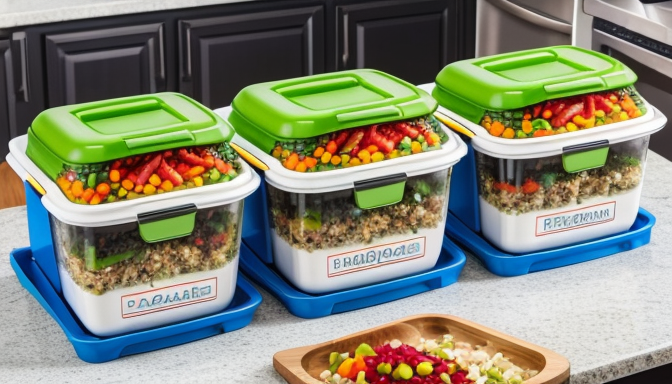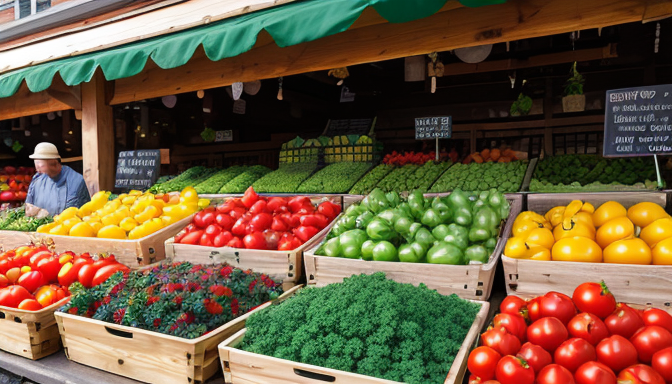Planning healthy meals doesn’t have to be a daunting task; in fact, it can be a fun and rewarding experience! Imagine stepping into your kitchen, ready to whip up delicious, nutritious meals that not only satisfy your taste buds but also fuel your body. The key is to approach meal planning with a strategy that works for you. So, how do you get started? Well, first things first, you need to understand your nutritional needs. This means considering factors like your age, activity level, and personal dietary preferences. Are you trying to lose weight, build muscle, or simply eat healthier? Knowing your goals will help you tailor your meal plan effectively.
Next, let’s talk about meal prep techniques. Think of meal prepping as your secret weapon in the battle against unhealthy eating habits. By dedicating just a few hours each week to prepare meals, you can ensure that you have healthy options readily available. Picture this: on a busy weekday, instead of reaching for takeout, you can grab a pre-made quinoa salad or a hearty vegetable stir-fry from your fridge. It’s all about making your life easier while keeping your diet on track.
Another tip is to get creative with ingredient swaps. For example, if a recipe calls for white rice, why not try brown rice or quinoa instead? These swaps can enhance the flavor and nutrition of your meals, keeping things exciting. Plus, incorporating seasonal produce can add a burst of freshness to your dishes. Think about it—when you use fruits and vegetables that are in season, not only do you get better taste, but you also support local farmers and reduce your carbon footprint.
Lastly, staying motivated and consistent is crucial. It’s easy to lose steam, but by setting small, achievable goals and celebrating your successes, you can maintain your momentum. Remember, healthy eating is a journey, not a sprint. So, grab those fresh ingredients, channel your inner chef, and enjoy the process of planning and preparing healthy meals!
Understanding Nutritional Needs
When it comes to planning healthy meals, understanding your nutritional needs is like having a roadmap for your health journey. Just as a car needs the right fuel to run smoothly, your body requires a balanced mix of nutrients to function at its best. But how do you determine what your body truly needs? It’s all about considering a few key factors.
First, think about your age. Nutritional requirements change as we grow older. For instance, children need more protein for growth, while older adults may need more calcium and vitamin D to maintain bone health. Next up is your activity level. Are you a couch potato or a gym rat? Active individuals generally need more calories and nutrients to support their energy expenditure. Lastly, dietary preferences play a crucial role. Whether you’re vegan, vegetarian, or a meat-lover, your meal plan should reflect what you enjoy eating while still meeting your nutritional needs.
To make this easier, you can break down your nutritional needs into categories. Here’s a simplified table to give you an idea:
| Factor | Nutritional Consideration |
|---|---|
| Age | Adjust macronutrients; younger individuals need more protein. |
| Activity Level | Higher energy needs for active lifestyles; focus on carbs and proteins. |
| Dietary Preferences | Choose foods that align with your lifestyle; ensure nutrient variety. |
Incorporating these considerations into your meal planning will not only help you meet your health goals but also make the process enjoyable. Remember, the key is to listen to your body and adjust as necessary. After all, what works for your friend may not work for you, and that’s perfectly okay!

Meal Prep Techniques
Meal prepping can seem daunting at first, but once you get the hang of it, you’ll wonder how you ever lived without it! Imagine opening your fridge and seeing a rainbow of healthy meals ready to go. That’s the magic of meal prep! It’s all about planning ahead, so you can save time and eat well throughout the week. Start by choosing a dedicated day—perhaps Sunday—where you can spend a few hours preparing meals for the week. This way, you’re not scrambling each day to figure out what to eat.
One effective technique is to batch cook. This means making large quantities of a few staple dishes that you can mix and match throughout the week. For example, you might prepare a big pot of quinoa, roast a variety of seasonal vegetables, and grill some chicken. With these components ready, you can create different meals by simply combining them in various ways. Not only does this save time, but it also keeps your meals exciting.
Another tip is to invest in good-quality containers. Clear, stackable containers not only keep your food fresh but also make it easy to see what you have on hand. Labeling your meals can also be a game changer! This simple step helps you avoid the dreaded “mystery meal” situation. You can even create a meal prep schedule to keep yourself organized. Here’s a quick example:
| Day | Meal |
|---|---|
| Monday | Grilled Chicken with Quinoa and Veggies |
| Tuesday | Veggie Stir-Fry with Brown Rice |
| Wednesday | Chickpea Salad with Avocado |
Lastly, don’t forget to include snacks! Prepping healthy snacks like cut-up fruits, nuts, or yogurt can help curb cravings and keep you on track. The key is to make it as easy and enjoyable as possible. Remember, meal prepping is not just about eating healthy; it’s about making your life easier and more delicious!
Creative Ingredient Swaps
When it comes to healthy eating, one of the biggest hurdles can be the monotony of flavors. But what if I told you that you could keep your meals exciting and nutritious with just a few ? Imagine transforming a bland dish into a culinary masterpiece by simply swapping out a few components. The beauty of cooking lies in its flexibility, and embracing this can lead to deliciously healthy meals.
For instance, if you’re a fan of creamy sauces but want to cut down on calories and fat, consider replacing heavy cream with Greek yogurt or silken tofu. Not only do these alternatives add creaminess, but they also pack a protein punch! Similarly, if you’re looking to reduce carbs, why not swap traditional pasta for zoodles (zucchini noodles) or spaghetti squash? These swaps not only lower the carb content but also add a vibrant touch to your plate.
Another fabulous swap is using quinoa instead of rice. Quinoa is a complete protein and is rich in fiber, making it a fantastic base for salads or stir-fries. And let’s not forget about the power of herbs and spices. Instead of relying on high-sodium sauces, try infusing your dishes with fresh herbs like basil, cilantro, or even a sprinkle of nutritional yeast for a cheesy flavor without the calories!
Here’s a quick table to illustrate some easy swaps:
| Traditional Ingredient | Creative Swap |
|---|---|
| Heavy Cream | Greek Yogurt / Silken Tofu |
| White Pasta | Zoodles / Spaghetti Squash |
| White Rice | Quinoa |
| Sodium-Rich Sauces | Fresh Herbs & Spices |
Incorporating these swaps not only enhances the flavor but also boosts the nutritional value of your meals. So, the next time you’re in the kitchen, think outside the box! Your taste buds and your body will thank you.

Incorporating Seasonal Produce
Have you ever bitten into a juicy, sun-ripened tomato in the summer and thought, “Wow, this is what real flavor tastes like?” That’s the magic of seasonal produce! Incorporating fruits and vegetables that are in season not only enhances the taste of your meals but also boosts their nutritional value. When you eat what’s in season, you’re tapping into nature’s calendar, which can lead to fresher, more flavorful dishes that are bursting with vitality.
So, how do you get started with seasonal produce? First, it’s essential to know what fruits and vegetables are available in your area throughout the year. For example, in the spring, you might find asparagus and strawberries, while fall brings pumpkins and apples. By planning your meals around these seasonal ingredients, you’re not just eating healthier; you’re also supporting local farmers and reducing your carbon footprint. It’s a win-win!
Here’s a quick breakdown of some seasonal produce:
| Season | Fruits | Vegetables |
|---|---|---|
| Spring | Strawberries, Cherries | Asparagus, Spinach |
| Summer | Watermelon, Peaches | Tomatoes, Zucchini |
| Fall | Apples, Pears | Pumpkins, Brussels Sprouts |
| Winter | Citrus Fruits, Pomegranates | Root Vegetables, Kale |
When you incorporate seasonal produce into your meals, think about the variety of colors and textures you can create. A vibrant salad with mixed greens, roasted beets, and sliced oranges can be a feast for the eyes as well as the palate. Plus, seasonal ingredients often have less environmental impact and are usually more affordable. So, next time you’re at the grocery store or farmer’s market, let the seasons guide your choices. Your taste buds—and your body—will thank you!
Staying Motivated and Consistent
Let’s face it: sticking to a healthy meal plan can feel like an uphill battle at times. But don’t worry! Staying motivated and consistent is totally achievable with the right mindset and a few handy strategies. Think of your meal planning journey as a marathon, not a sprint. It’s all about pacing yourself and celebrating those small victories along the way.
One of the best ways to keep your motivation high is to set realistic goals. Instead of aiming for perfection, focus on making gradual changes that fit into your lifestyle. For instance, if you’re used to grabbing fast food for lunch, try preparing a couple of healthy meals each week to take with you. You’ll be surprised at how satisfying it is to enjoy a homemade dish packed with nutrients!
Another effective strategy is to find a meal prep buddy. Having someone to share your journey with can make the process more enjoyable and keep you accountable. You can swap recipes, share tips, or even cook together! Plus, it’s way more fun to chat while chopping veggies than to do it alone.
Don’t forget to keep things interesting! Variety is key to maintaining your enthusiasm for healthy meals. Try to incorporate a mix of flavors, textures, and colors into your dishes. This not only makes your meals visually appealing but also ensures you’re getting a wide range of nutrients. For instance, you might consider using seasonal produce, which can add excitement and freshness to your meals.
Lastly, always remind yourself why you started this journey. Whether it’s to feel more energetic, improve your health, or just fit into those favorite jeans, keeping your end goal in mind can be a powerful motivator. And remember, it’s perfectly okay to indulge occasionally! Balance is essential, and enjoying your favorite treats in moderation can help you stay on track in the long run.
Frequently Asked Questions
- What are some easy meal prep ideas for beginners?
Starting with simple recipes is key! Think about dishes like stir-fries, quinoa salads, or overnight oats. These meals are not only easy to prepare but also versatile, allowing you to mix and match ingredients based on what you enjoy.
- How do I know what my nutritional needs are?
Your nutritional needs can vary based on factors like age, activity level, and health goals. A good rule of thumb is to consult with a health professional or use online calculators that take these factors into account to help you create a balanced meal plan.
- Can I make healthy meals taste good?
Absolutely! Using herbs, spices, and healthy fats can elevate the flavor of your meals. Don’t be afraid to experiment with different ingredient swaps to find what excites your taste buds!
- How can I stay motivated to stick to my meal plan?
Staying motivated can be a challenge, but setting small, achievable goals can help! Also, consider meal prepping with friends or family to make it a fun activity. Keeping your meals colorful and varied can also keep things interesting!
- What are the benefits of using seasonal produce?
Using seasonal produce not only enhances the flavor of your meals but also ensures you’re getting the freshest ingredients. Plus, it’s often more affordable and supports local farmers, making it a win-win!

